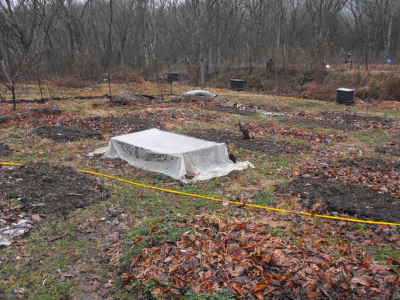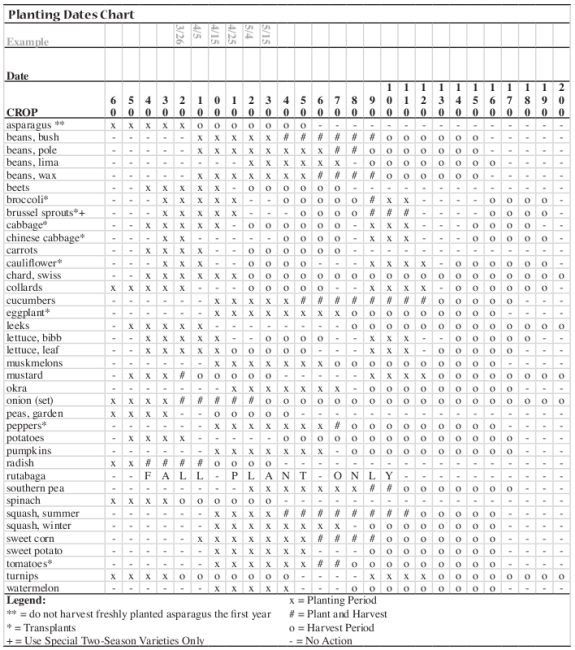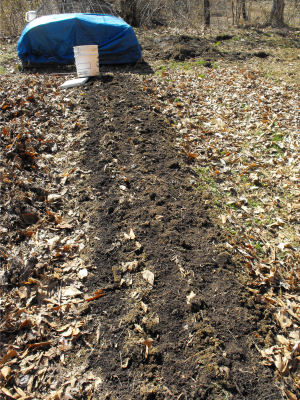
Spring planting dates
 One
of the most common questions I hear from new gardeners is, "When should
I plant my first spring vegetables?" I'm not surprised that folks
are confused since there seem to be several schools of thoughts on the
matter.
One
of the most common questions I hear from new gardeners is, "When should
I plant my first spring vegetables?" I'm not surprised that folks
are confused since there seem to be several schools of thoughts on the
matter.
Around here, many people
plant by the signs. You pick up a calendar at the local hardware
store with phases of the moon and planting dates on it, then put your
seeds in the ground when the moon dictates. People who plant by
the signs also tend to believe that you need to put in your fence posts
at a certain phase of the moon, but I've yet to meet anyone who set up
a controlled experiment to test the effects of the moon's phase on
their garden. I dismiss planting by the signs as voodoo, although
I would like to see some scientific data one way or the other.
The next faction is the
scientific set, of which I'm partially a member. They figure out
their local frost free date (May 15 here in the mountains of southwest
Virginia) then download a spring planting chart and use some simple
math to figure out their planting dates. The chart below comes
from the Virginia Cooperative Extension, and I've posted an
explanation of how to use it here. Note that the example
assumes a frost free date of April 15.

I used a chart like this
to make a spreadsheet with optimal planting dates on it, but I don't
mark the exact dates on my calendar. Our seasons can be so
variable that I suspect the best way to figure out optimal planting
dates is to pay attention to natural signs, like when the first chorus
frogs begin to call or when certain flowers bloom. These plants
and animals are more alert to the intricacies of soil and air
temperature than we are, and chances are they know best.
 Unfortunately,
I haven't got this method really figured out yet, beyond the old saying
that you'd best plant your corn when the oak leaves are as big as a
squirrel's ear. So, for now, I just add in a one week window on
either side of the "optimal planting dates" to allow for rain, drought,
strange freezes, or warm spells. For example, although I'm slated
to plant our main crop of peas next week, we rushed and put them in the
ground on Thursday morning before the rain came. The ground is
warm enough that my hands don't freeze as I pull weeds, and the less
clayey areas are actually drying up on top (though some of the clayey
beds would have liked a few more days to evaporate winter's
moisture.) I figured I'd be better off putting my peas in the
ground now than waiting until the ground is dry again, which may not
happen for over a week.
Unfortunately,
I haven't got this method really figured out yet, beyond the old saying
that you'd best plant your corn when the oak leaves are as big as a
squirrel's ear. So, for now, I just add in a one week window on
either side of the "optimal planting dates" to allow for rain, drought,
strange freezes, or warm spells. For example, although I'm slated
to plant our main crop of peas next week, we rushed and put them in the
ground on Thursday morning before the rain came. The ground is
warm enough that my hands don't freeze as I pull weeds, and the less
clayey areas are actually drying up on top (though some of the clayey
beds would have liked a few more days to evaporate winter's
moisture.) I figured I'd be better off putting my peas in the
ground now than waiting until the ground is dry again, which may not
happen for over a week.
Of course, the real
reason I planted our main crop of peas early is because I talked to my
garden guru on Monday and she'd just planted peas in her own
garden. Gotta keep up with the Joneses!
Want more in-depth information? Browse through our books.
Or explore more posts by date or by subject.
About us: Anna Hess and Mark Hamilton spent over a decade living self-sufficiently in the mountains of Virginia before moving north to start over from scratch in the foothills of Ohio. They've experimented with permaculture, no-till gardening, trailersteading, home-based microbusinesses and much more, writing about their adventures in both blogs and books.
Want to be notified when new comments are posted on this page? Click on the RSS button after you add a comment to subscribe to the comment feed, or simply check the box beside "email replies to me" while writing your comment.

Anna since I'll be moving to the mountains of SWVA as well, and since I have no clue about the seasons there (yet) I'd LOVE to be able to download YOUR spreadsheet instead of the one from the extension agent. You have my email. I'd be happy to repay the kindness with some yield, although we're getting a late start this year.
Off to Paris and Amsterdam for two weeks starting tomorrow, and when I get back we're loading up the truck and shipping off to Virginia!
I'm always thrilled to share my spreadsheet. Also, when you're in the area, let me know --- I'd be glad to get you started on some of the perennials that every garden in our area should have --- things like Egyptian onions, bee balm, fennel, comfrey, etc.
Have a great trip!
I came across you blog by accident and found myself sitting here reading everything. I was born in Va. and grew up there on my grandparents farm and watched everything they did. I might be able to chime in once in awhile to give you some hints about the things they did. They were very good farmers. Plus, I have a green thumb. My grandparents went by the moon...it does work. It works on the tides and I know for a fact it works on calving etc... You must try it. It is a science not folklore...the Indian's have proved that it works. So there you go! Pull the information up on your internet...it will give you all the details of it. Thanks for the bread recipe...I can't wait to try it out! I am a cowgirl. I have cattle here in East Texas and an putting in a vineyard. I visit Va. often and miss it with all my heart...it is my true home.